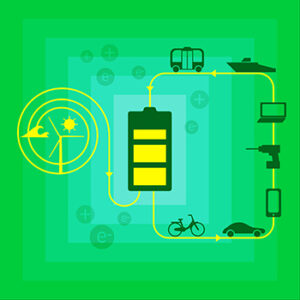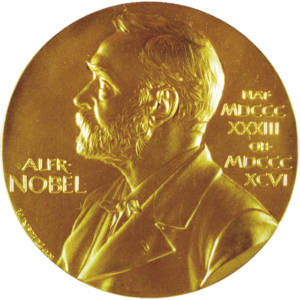The Royal Swedish Academy of Sciences has decided to award the Nobel Prize in Chemistry 2019 to John B. Goodenough, The University of Texas at Austin, USA, M. Stanley Whittingham, Binghamton University, State University of New York, USA and Akira Yoshino, Asahi Kasei Corporation, Tokyo, Japan och Meijo University, Nagoya, Japan.
“for the development of lithium-ion batteries”
They created a rechargeable world

The Nobel Prize in Chemistry 2019 rewards the development of the lithium-ion battery. This lightweight, rechargeable and powerful battery is now used in everything from mobile phones to laptops and electric vehicles. It can also store significant amounts of energy from solar and wind power, making possible a fossil fuel-free society.
Lithium-ion batteries are used globally to power the portable electronics that we use to communicate, work, study, listen to music and search for knowledge. Lithium-ion batteries have also enabled the development of long-range electric cars and the storage of energy from renewable sources, such as solar and wind power.
The foundation of the lithium-ion battery was laid during the oil crisis in the 1970s. Stanley Whittingham worked on developing methods that could lead to fossil fuel-free energy technologies. He started to research superconductors and discovered an extremely energy-rich material, which he used to create an innovative cathode in a lithium battery. This was made from titanium disulphide which, at a molecular level, has spaces that can house – intercalate – lithium ions.
The battery’s anode was partially made from metallic lithium, which has a strong drive to release electrons. This resulted in a battery that literally had great potential, just over two volts. However, metallic lithium is reactive and the battery was too explosive to be viable.
John Goodenough predicted that the cathode would have even greater potential if it was made using a metal oxide instead of a metal sulphide. After a systematic search, in 1980 he demonstrated that cobalt oxide with intercalated lithium ions can produce as much as four volts. This was an important breakthrough and would lead to much more powerful batteries.
With Goodenough’s cathode as a basis, Akira Yoshino created the first commercially viable lithium-ion battery in 1985. Rather than using reactive lithium in the anode, he used petroleum coke, a carbon material that, like the cathode’s cobalt oxide, can intercalate lithium ions.
The result was a lightweight, hardwearing battery that could be charged hundreds of times before its performance deteriorated. The advantage of lithium-ion batteries is that they are not based upon chemical reactions that break down the electrodes, but upon lithium ions flowing back and forth between the anode and cathode.
Lithium-ion batteries have revolutionised our lives since they first entered the market in 1991. They have laid the foundation of a wireless, fossil fuel-free society, and are of the greatest benefit to humankind.
 John B. Goodenough, born 1922 in Jena, Germany. Ph.D. 1952 from the University of Chicago, USA. Virginia H. Cockrell Centennial Chair in Engineering at The University of Texas at Austin, USA.
John B. Goodenough, born 1922 in Jena, Germany. Ph.D. 1952 from the University of Chicago, USA. Virginia H. Cockrell Centennial Chair in Engineering at The University of Texas at Austin, USA.
Stanley Whittingham, born 1941 in the UK. Ph.D. 1968 from Oxford University, UK. Distinguished Professor at Binghamton University, State University of New York, USA.
Akira Yoshino, born 1948 in Suita, Japan. Ph.D. 2005 from Osaka University, Japan. Honorary Fellow at Asahi Kasei Corporation, Tokyo, Japan and professor at Meijo University, Nagoya, Japan.
Prize amount: 9 million Swedish krona, to be shared equally between the Laureates.
The Royal Swedish Academy of Sciences, founded in 1739, is an independent organisation whose overall objective is to promote the sciences and strengthen their influence in society. The Academy takes special responsibility for the natural sciences and mathematics, but endeavours to promote the exchange of ideas between various disciplines.
Nobel Prize® and the Nobel Prize® medal design mark are registered trademarks of the Nobel Foundation.
Documents
The illustrations are free to use for non-commercial purposes. Attribute “©Johan Jarnestad/The Royal Swedish Academy of Sciences”.
Illustration: The Nobel Prize in Chemistry 2019
Illustration: Periodic table, lithium
Illustration: Whittinghams battery
Illustration: Whiskers from lithium
Illustration: Goodenoughs battery
Illustration: Yoshinos battery
Contact
Press contact
Eva Nevelius, Press Secretary, The Royal Swedish Academy of Sciences
+46 8 673 95 44, +46 70 878 67 63, eva.nevelius@kva.se
Expert
Olof Ramström, member of the Nobel Committee for Chemistry, The Royal Swedish Academy of Sciences
+46 70 433 42 60, ramstrom@protonmail.com
More information
The Laureates
John B. Goodenough, The University of Texas at Austin
Stanley Whittingham, Binghamton University
Akira Yoshino, Asahi Kasei Corporation